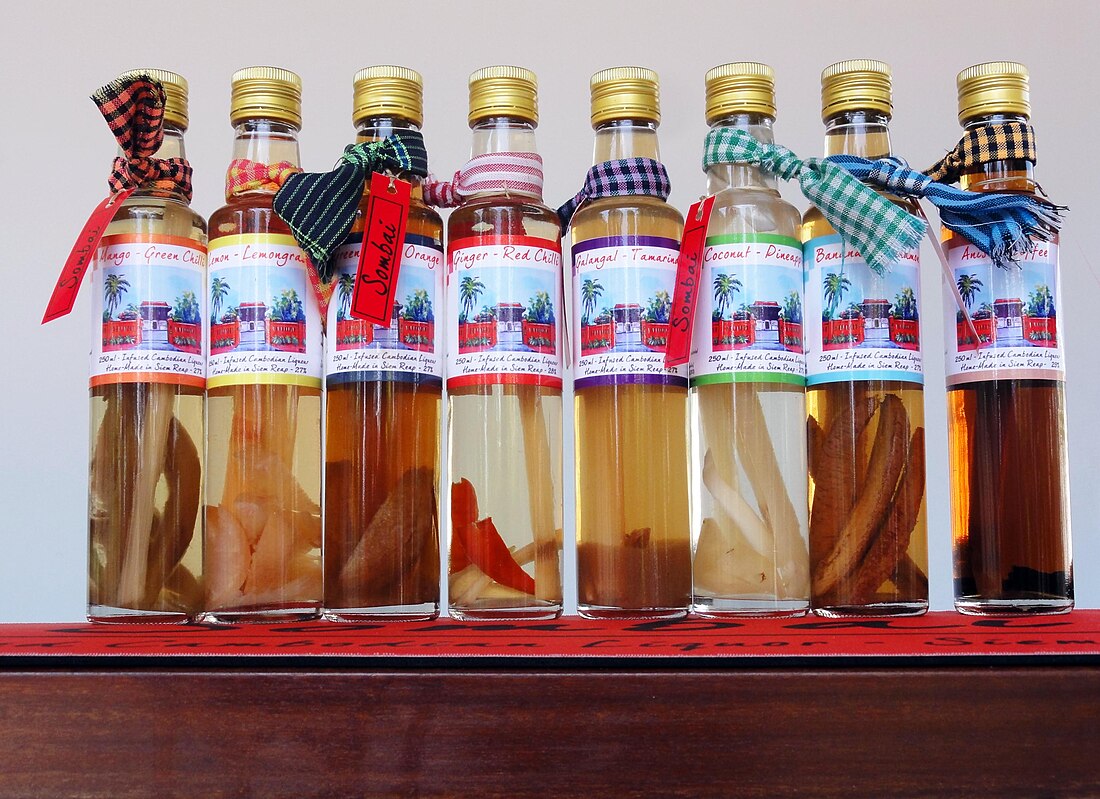Top Qs
Timeline
Chat
Perspective
Rice wine
Alcoholic beverage made from fermented rice From Wikipedia, the free encyclopedia
Remove ads
Rice wine is an alcoholic beverage fermented from rice, traditionally consumed in East Asia, Southeast Asia and South Asia, where rice is a quintessential staple crop. Rice wine is made by the fermentation of rice starch, during which microbes enzymatically convert polysaccharides to sugar and then to ethanol.[1] The Chinese mijiu (most famous being huangjiu), Japanese sake, and Korean cheongju, dansul and takju are some of the most notable types of rice wine.
This article needs additional citations for verification. (June 2008) |

Rice wine typically has an alcohol content of 10–25% ABV, and is typically served warm. One panel of taste testers arrived at 60 °C (140 °F) as an optimum serving temperature.[2] Rice wines are drunk as a dining beverage in East Asian, Southeast Asian and South Asian cuisine during formal dinners and banquets, and are also used as cooking wines to add flavors or to neutralize unwanted tastes in certain food items (e.g. seafood such as fish and shellfish).
Remove ads
History
This article appears to contradict the article Alcoholic beverage. (December 2024) |
The production of rice wine has thousands of years of history. In ancient China, rice wine was the primary alcoholic drink. One of the first known fermented beverages in the world to use rice as an integral ingredient was a drink made from rice and honey about 9,000 years ago in central China.[3] In the Shang Dynasty (1750-1100 BCE), funerary objects routinely featured wine vessels.[4] The production of rice wine in Japan is believed to have started around third century BCE, after the introduction of wet rice cultivation.[5]
As a result of Alexander the Great's expedition to India, the Roman Empire had begun importing rice wine by the first century BCE.[6]
Remove ads
Production
Despite being called a wine, the rice wine's production process has some similarities to that of brewing beer, reflecting its chief ingredient being a grain rather than a fruit. The specific approaches to making rice wine vary by type. Some rice wine (such as the Chinese rice wine, or mijiu) is made from glutinous rice, while others (such as the Japanese Sake) is made from non-glutinous rice. However, all systems combine rice with some fungal culture in some ways. The fungal culture is called jiuqu in Chinese and koji in Japanese. In the traditional Chinese rice-wine-making approach, the glutinous rice is soaked for several days before being steamed, and subsequently is left to cool in a ceramic vat at near room temperature. Then, the jiuqu is added and mixed with the rice. The primary functions of jiuqu are to supply enzymes to convert starch to sugar and to supply yeast for ethanol production. After a few days, the liquid formed in the ceramic vat is combined with an additional mix of water and fungi to adjust the rice wine's water content.[7]
Remove ads
Types
Summarize
Perspective
Remove ads
See also
References
Further reading
External links
Wikiwand - on
Seamless Wikipedia browsing. On steroids.
Remove ads
